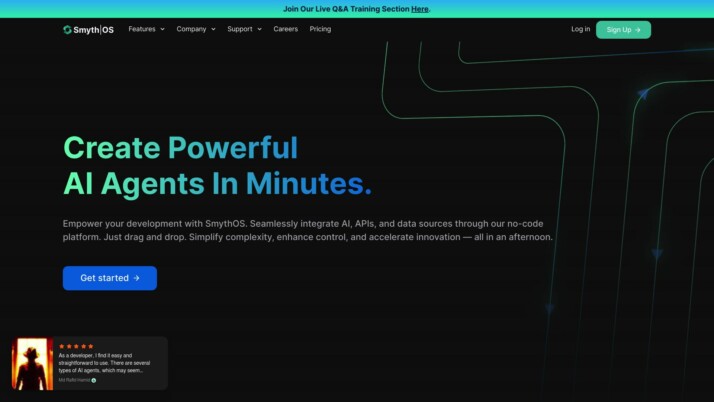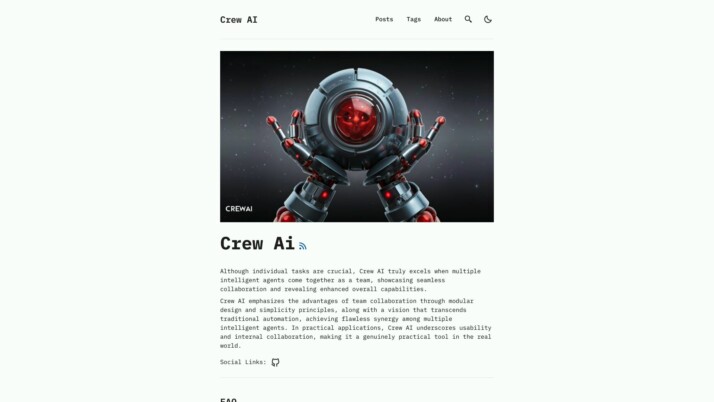SmythOS vs. Crew AI: Key Features Compared
In a world where AI is becoming ubiquitous across sectors and applications, businesses and individuals alike are seeking powerful yet accessible solutions to harness the potential of this revolutionary technology. As we explore the capabilities of SmythOS vs. Crew AI, two leading platforms in the AI arena, it becomes evident that they cater to distinct audiences and offer unique strengths.
Whether you’re a seasoned developer, a business leader, or an enthusiastic novice, this comparative review will guide you in understanding the key features, use cases, and advantages of each platform, empowering you to make an informed decision tailored to your specific needs.
SmythOS Overview
SmythOS is a groundbreaking AI operating system that revolutionizes the creation and deployment of AI agents. At its core, SmythOS offers a powerful drag-and-drop interface, enabling users to construct complex AI workflows seamlessly without extensive coding knowledge. This user-friendly approach makes advanced AI capabilities accessible to a wide range of users, from developers and technical teams to non-technical professionals and small businesses.
SmythOS offers a powerful drag-and-drop interface, enabling users to construct complex AI workflows seamlessly without extensive coding knowledge.
One of the key strengths of SmythOS lies in its extensive integration ecosystem. The platform supports a vast array of APIs, AI models (including OpenAI, Anthropic, and Hugging Face), and tools, allowing users to seamlessly incorporate functionalities from popular services like Slack, Trello, GitHub, and Stripe into their workflows. Additionally, SmythOS provides pre-built templates and connectors for common tasks, significantly reducing setup time and fostering rapid innovation.


A standout feature of SmythOS is its support for multi-agent orchestration, enabling teams of AI agents to collaborate seamlessly on complex tasks. This capability enhances efficiency and scalability, making SmythOS suitable for enterprise-level deployments. Furthermore, the platform offers versatile deployment options, allowing agents to be integrated into existing systems, deployed as APIs, chatbots, or even as ChatGPT plugins or Alexa skills.
Crew AI Overview
Crew AI is an open-source framework that enables developers to orchestrate collaborative teams of AI agents to tackle complex tasks. Its core innovation lies in allowing specialized AI agents with defined roles and goals to work together cohesively through structured workflows and processes.
The framework provides tools for developers to configure AI agents, assign them specific tasks and skills, and manage their coordinated collaboration through configurable processes. This modular approach aims to simplify the challenges of building sophisticated multi-agent AI systems.


Some of the key capabilities and best use cases for Crew AI include intelligent process automation flows, chatbot teams coordinating responses, automated assistive ensembles for tasks like customer support, distributed data orchestration pipelines, and multi-modal dialogue applications. The framework’s flexible architecture allows developers to tailor agent roles, tasks, and coordination strategies to meet specific application needs.
Feature Comparison
SmythOS is a comprehensive AI platform that offers a wide range of features and capabilities for building, deploying, and managing AI agents. At its core, SmythOS provides a user-friendly drag-and-drop interface, enabling users to create complex AI workflows without extensive coding knowledge.
SmythOS’s visual builder, combined with the platform’s no-code editor, democratizes AI development and makes it accessible to a broader audience.
In contrast, Crew AI is an open-source framework focused on enabling developers to orchestrate collaborative teams of AI agents. While Crew AI allows developers to configure agent roles, tasks, and coordination strategies, it lacks many of the user-friendly features and extensive integrations offered by SmythOS.
One of the key strengths of SmythOS lies in its extensive integration ecosystem. The platform supports a vast array of APIs, AI models (including OpenAI, Anthropic, and Hugging Face), and tools, allowing users to seamlessly incorporate functionalities from popular services like Slack, Trello, GitHub, and Stripe into their workflows. This flexibility ensures that SmythOS can fit into virtually any workflow or business process, while Crew AI’s integration capabilities appear to be more limited.
Moreover, SmythOS offers a range of deployment options, allowing agents to be integrated into existing systems, deployed as APIs, chatbots, or even as ChatGPT plugins or Alexa skills. This versatility is not apparent in Crew AI’s feature set, which seems to focus primarily on enabling multi-agent collaboration within its own framework.
Another key differentiator is SmythOS’s support for a wide range of features such as memory and context management, autonomous agents, explainability and transparency, debugging tools, and multimodal capabilities. These features are essential for building sophisticated AI systems, yet they are not explicitly mentioned in Crew AI’s documentation, suggesting a more limited scope in terms of individual agent capabilities.
| SmythOS | Crew AI | |
|---|---|---|
| CORE FEATURES | ||
| Hosted Agents (Dev/Production) | ✅ | ❌ |
| Environments (Dev/Production) | ✅ | ❌ |
| Visual Builder | ✅ | ❌ |
| No-Code | ✅ | ❌ |
| Explainability & Transparency | ✅ | ❌ |
| Debug Tools | ✅ | ❌ |
| Multimodal | ✅ | ❌ |
| Audit Logs for Analytics | ✅ | ❌ |
| SECURITY | ||
| Constrained Alignment | ✅ | ❌ |
| Data Encryption | ✅ | ❌ |
| OAuth | ✅ | ❌ |
| IP Control | ✅ | ❌ |
| COMPONENTS | ||
| Foundation AIs | ✅ | ❌ |
| Huggingface AIs | ✅ | ❌ |
| Zapier APIs | ✅ | ❌ |
| All other APIs/RPA | ✅ | ❌ |
| Logic | ✅ | ❌ |
| DEPLOYMENT OPTIONS | ||
| Deploy as API | ✅ | ❌ |
| Deploy as Webhook | ✅ | ❌ |
| Deploy as Site Chat | ✅ | ❌ |
| Deploy as Scheduled Agent | ✅ | ❌ |
| DATA LAKE SUPPORT | ||
| Hosted Vector Database | ✅ | ❌ |
| Sitemap Crawler | ✅ | ❌ |
| YouTube Transcript Crawler | ✅ | ❌ |
| URL Crawler | ✅ | ❌ |
| PDF Support | ✅ | ❌ |
| Word .doc File Support | ✅ | ❌ |
| TXT File Support | ✅ | ❌ |
Conclusion
With its groundbreaking AI operating system, SmythOS empowers users to revolutionize their workflows and unlock the full potential of artificial intelligence. By offering an extensive integration ecosystem, a user-friendly drag-and-drop interface, and support for a wide range of AI models and APIs, SmythOS makes advanced AI capabilities accessible to a diverse audience, from developers and technical teams to businesses, non-technical users, and researchers.
SmythOS’s ability to orchestrate multi-agent collaboration, combined with versatile deployment options, ensures that it can be seamlessly incorporated into any workflow or business process.
To experience the transformative power of SmythOS firsthand, visit our templates page and explore pre-built workflows tailored to your needs. You can also create a free account to start building your own custom AI agents and leverage over 300,000 integrations to streamline your processes. With the ability to deploy agents anywhere, SmythOS offers unparalleled flexibility and scalability for your AI endeavors. For comprehensive guidance, refer to our detailed documentation. Don’t miss out on the opportunity to harness the power of AI with SmythOS – sign up for a free trial today and see the difference for yourself!
Last updated:
Disclaimer: The information presented in this article is for general informational purposes only and is provided as is. While we strive to keep the content up-to-date and accurate, we make no representations or warranties of any kind, express or implied, about the completeness, accuracy, reliability, suitability, or availability of the information contained in this article.
Any reliance you place on such information is strictly at your own risk. We reserve the right to make additions, deletions, or modifications to the contents of this article at any time without prior notice.
In no event will we be liable for any loss or damage including without limitation, indirect or consequential loss or damage, or any loss or damage whatsoever arising from loss of data, profits, or any other loss not specified herein arising out of, or in connection with, the use of this article.
Despite our best efforts, this article may contain oversights, errors, or omissions. If you notice any inaccuracies or have concerns about the content, please report them through our content feedback form. Your input helps us maintain the quality and reliability of our information.
